Definition
The latissimus dorsi muscle, named after the Latin term latus (wide) and dorsi (back), is a flat, wing-like muscle that stretches from its origins at the lower thoracic vertebrae, lower ribs, scapula and iliac crest and attaches or inserts at a groove in the bone of the upper arm (humerus). It allows us to extend, adduct, abduct (bring away from the body) and flex the shoulder joint. It also plays a role in lumbar spine extension (straightening) and sideways bending (lateral flexion).
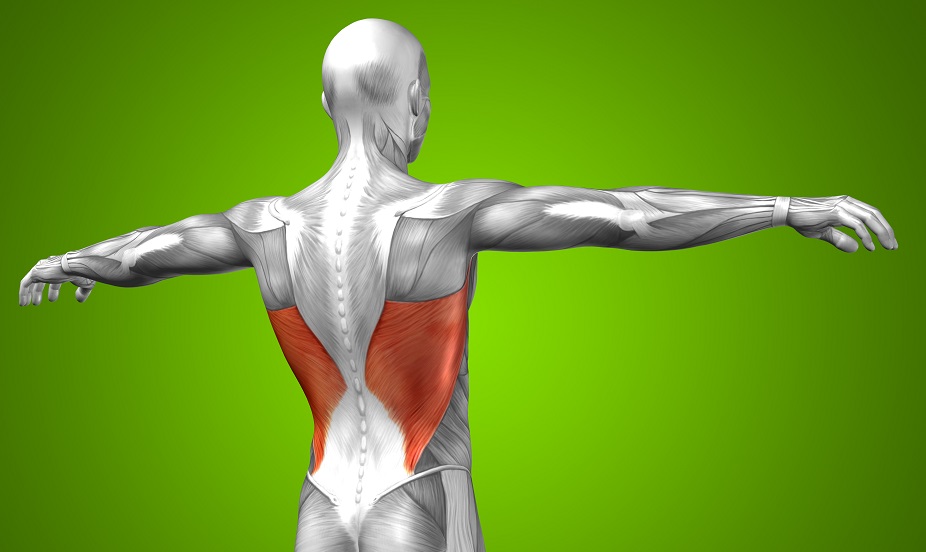
Latissimus Dorsi Location
The location of the latissimus dorsi is at the mid back. If the spine is seen as the bottom of a triangle and the attachment to the humerus as the apex of this triangle, it is quite easy to picture one side of the muscle. This triangular or wing-like form is mirrored on the other side of the body, although this muscle is a single muscle split into left and right segments. The upper sides of each triangle cross the lower regions of the scapulae or shoulder blades.
The latissimus dorsi is the largest muscle of the human body but is not the strongest at less than one centimeter in thickness. As a human can function normally without it, this muscle is often used to close large wounds or substitute lost tissue in reconstructive surgery.
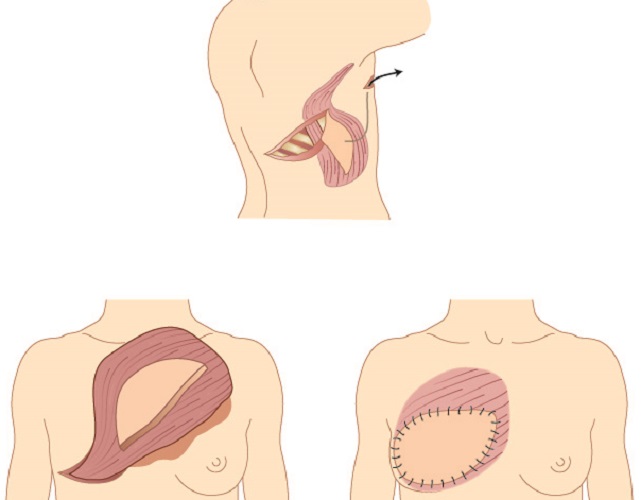
Latissimus Dorsi Function
When looking at latissimus dorsi function, we need to know the origin and insertion of the muscle. All muscles originate at one or more sites and insert into one or more other locations. The origin is a fixed point that does not move. The insertion points are areas where movement is possible. This means that the direction of movement is always from the insertion point to the origin. Latissimus dorsi origin and insertion is described in more detail below.
This muscle does not work alone. An entire group of different muscles move the shoulders and arms. These include the pectoralis major, latissimus dorsi, trapezius, serratus anterior, and deltoid muscles. Another important muscle group is the rotator cuff. The rotator cuff is composed of four muscles: the supraspinatus, infraspinatus, teres minor, and subscapularis (SITS). They originate at the scapula and, like the latissimus dorsi, insert at the humerus. All of these muscles work with or against each other to allow a wide range of upper extremity movement.
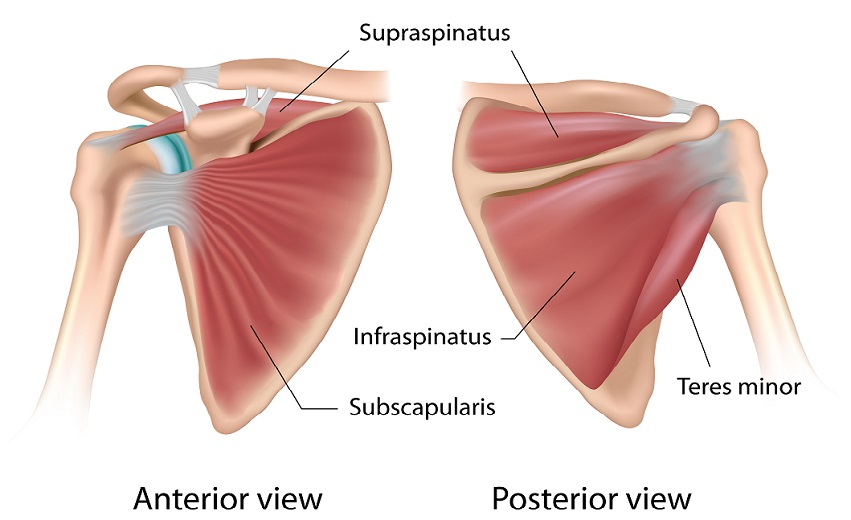
The origins of the latissimus dorsi muscle are many, most of them at the vertebrae. These origins are:
- Thoracic vertebrae 7 to 12
- Lumbar vertebrae 1 to 5
- Bottom angle of the shoulder blade (scapula)
- Bottom 3 to 4 ribs
- Posterior iliac crest
- Posterior sacrum
There is only one insertion point, at the intertubercular groove at the top of the humerus. You can see where this groove is located in the below image. This means that when it contracts it pulls the upper arm in the direction of the hip and back. As the wing-shape lies over the bottom of the shoulder blades, this muscle also helps to keep these mobile bones in place.
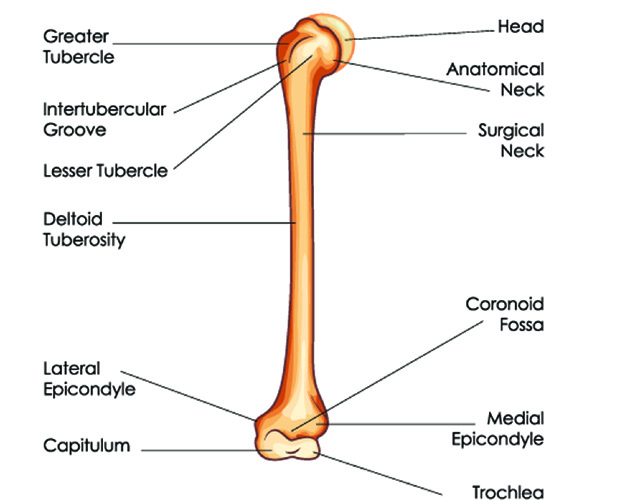
Latissimus dorsi function is often described as a climbing muscle but it is also a major contributor to movements such as rowing, some swimming strokes, and handling an axe when lifting it high over the head and bringing it down.
This muscle also plays a minor role whenever we breath out. If you cough, you will feel the wing-shaped muscle on either side of your back contract. As it contracts it makes the thoracic space smaller and helps to push the air in the lungs out.
However, even though this muscle seems to play multiple roles, is it not of extreme importance. When muscles from other parts of the body are needed to close large wounds as surgical free flaps, the latissimus dorsi is a good choice. One small study showed that even when this muscle is completely removed, most patients encounter little difficulty with shoulder movement and can continue former activities without any problem.
Latissimus Dorsi Movements
Latissimus dorsi action depends heavily on other muscles. We have also learned that without this particular muscle, movement is more often than not unaffected.
Other muscles act as agonist and antagonist pairs to provide excellent range of motion in the shoulder. An agonist muscle is the source of the force needed to finish a movement and to achieve this it must contract (shorten) or relax (lengthen). As it is the agonist that produces the force, it is also referred to as the prime mover. An antagonist muscle works in an opposite way to the agonist. That is why these muscles must work in pairs. If the agonist contracts, the antagonist relaxes and vice versa. Antagonists keep their part of the body in position. The biceps and triceps are common examples of antagonist and agonist muscle pairs. In the image you can see how one relaxes and the other contracts to produce movement in the elbow joint.
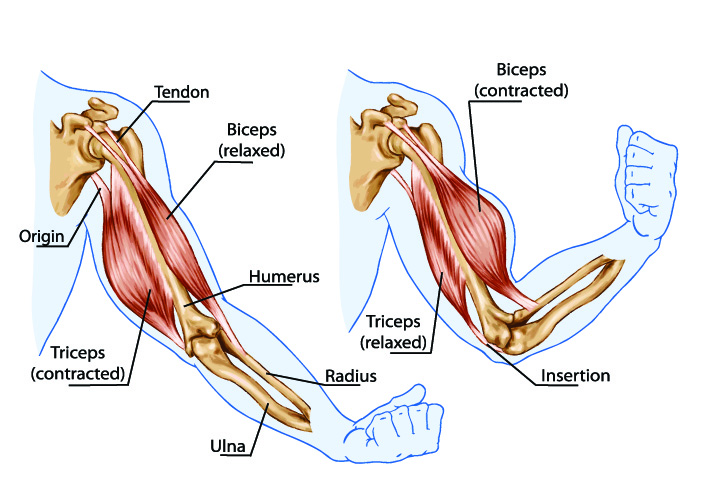
A further muscle category is the synergist that supports the agonist. It can both stabilize the joint and reduce the energy needed for the agonist to work. If the agonist contracts, the synergist will also contract. Sometimes, the latissimus dorsi acts as a synergist.
Adduction and Abduction
If you form a letter T with your arms and body and then bring one or both arms from a horizontal position back down to your sides, the downward movement is adduction. The main arm adductor agonists are the pectoralis major, the latissimus dorsi, and the teres major. Antagonist movements come from the deltoid, trapezius, and supraspinatus muscles.
In abduction, you move your arms away from your sides. For this opposite movement, the latissimus dorsi is no longer an agonist but an antagonist, while the deltoid muscles become primary movers.
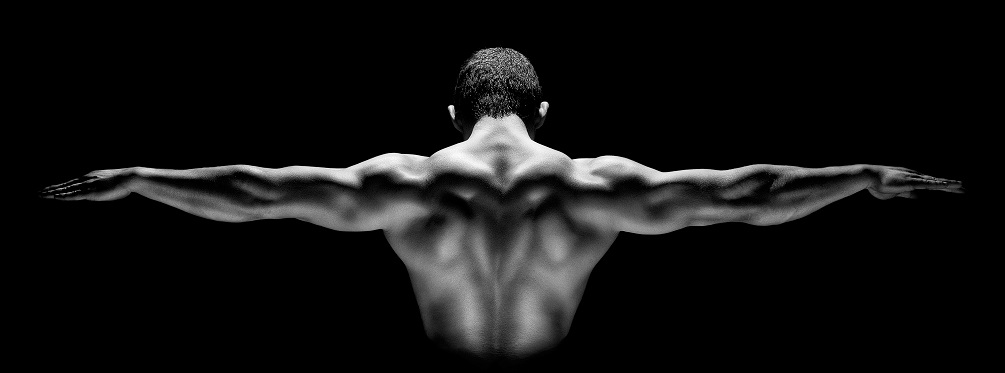
Extension
If you keep your arm at your side and swing it backwards from the shoulder, you are performing shoulder hyperextension. If you have just swung your arm forward from the shoulder, bringing it back into a more neutral position is called shoulder extension. The latissimus dorsi is not involved in hyperextension and has a very minor effect even when bringing a flexed shoulder back into a neutral position.
In transverse extension, however, like when you bring the shoulders and elbows back during rowing exercises (see below), the latissimus dorsi becomes a prime mover together with the posterior deltoid muscle. The antagonists for transverse extension are the anterior deltoid muscles, pectoralis major, and biceps.

Internal Rotation
For internal rotation or medial rotation of the shoulder bend one arm, keeping the elbow close to your side, and point your hand forward. Now move your lower arm across your abdomen towards the opposite side of the body. Can you feel the movement in your shoulder? You are experiencing internal rotation of this joint. The main agonists for internal rotation are the pectoralis major, latissimus dorsi, and anterior deltoid muscle. Antagonists are the teres minor, infraspinatus, and posterior deltoid muscles.

Trunk Movement
The latissimus dorsi plays less important roles in movements of the trunk; these are more the result of the erector spinae and abdominal muscles. While it is a prime mover when keeping the trunk upright (extension) and an antagonist when flexing the trunk forward, its role in trunk rotation and lateral flexion to the side is as synergist.
Pelvic Movement
As the latissimus dorsi also inserts at the iliac crest of the pelvis, it acts as a synergist in the anterior (forward) and lateral (to the side) pelvic tilt. When the latissimus dorsi is overactive through bad posture it can pull the hip forward – or to one side if only the left or right segment of muscle is damaged.
Scapular Movement
Finally, the shoulder blades also use the latissimus dorsi as synergists; more specifically it is a neutralizing synergist or stabilizer. As this thin sheet of muscle covers the lower portions of both scapulae it keeps them stable during movement. In the image below you can see where the horizontal sheet of the latissimus dorsi just covers the bottom of the shoulder blades.
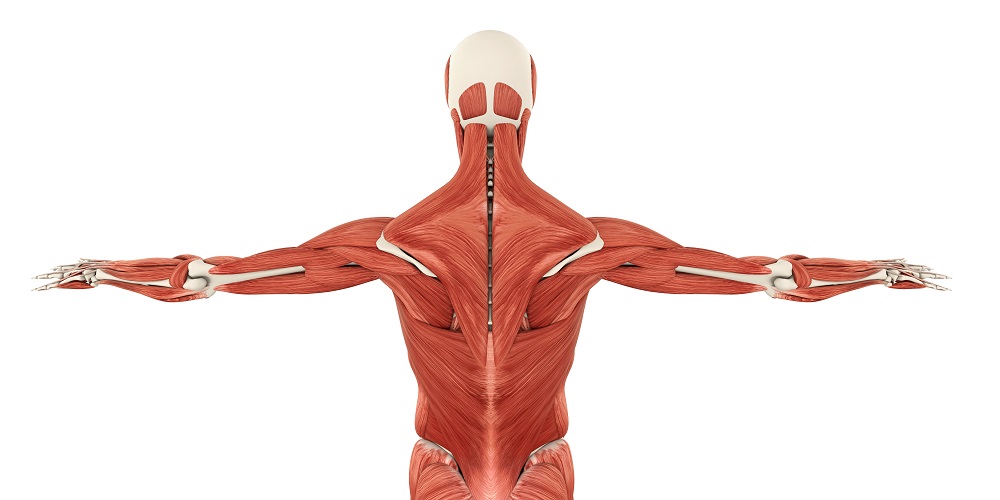
Latissimus Dorsi Pain
For patients with lower back pain, one possible cause is a stiff, shortened latissimus dorsi muscle that pulls on the spine and pelvis. Long-term shortening can lead to chronic back pain as the body will try to compensate, perhaps tilting the pelvis to one side and changing how a person walks. These compensatory effects can lead to permanent injury. Latissimus dorsi strain is often the result of brisk shoulder movement without first warming up the muscle and should be treated with a period of rest and frequent, short-term application of ice. To prevent further latissimus dorsi strain try some of the exercises further on.
Latissimus dorsi muscle tears are quite rare but nearly always related to specific sporting activities. The hyperlinked article reports latissimus dorsi tears in rock climbers, rodeo steer wrestlers, golfers, skiers, body builders, baseball players, tennis players, gymnasts, volleyball players, and basketball players. Practically all of these activities combine extreme upper arm movement with rotation of the trunk. Even so, injury to this muscle is not easy to diagnose as the muscle is so large and covers a multiple regions. Latissimus dorsi pain may be felt anywhere in the back, behind the shoulders, under the shoulder blades, and even down to the fingertips. To test if pain is caused by an injury to this muscle, the person should check whether discomfort increases with the arms lifted over the head, when throwing, or when stretching the arms forward at shoulder height.

Latissimus Dorsi Exercises
Latissimus dorsi exercises will only work efficiently if the muscle is first gently warmed up using the correct technique and with the right posture.
Your regime should begin with the latissimus dorsi side stretch. Stand straight and imagine a cord is attached to the top of your skull and is pulling you tall. You back should be straight and your hips relaxed. Your feet should be slightly apart. Lift both arms above your head and lean to one side until you can feel a stretch in the upper back. Hold this position for ten seconds and gently return to the original position. Repeat, leaning to the opposite side. Each side should be stretched at least fifteen times, gradually increasing the sideward movement without feeling pain.

The next latissimus dorsi stretch – the back bow – requires you to lie on your tummy. Stretch your arms forward and point your feet. Using only your back muscles, bring the shoulders and lower limbs up. The goal is to look like Superman or Supergirl flying through the air. Hold this position for as long as you can without experiencing any pain and gently return to the original position. Repeat at least ten times.
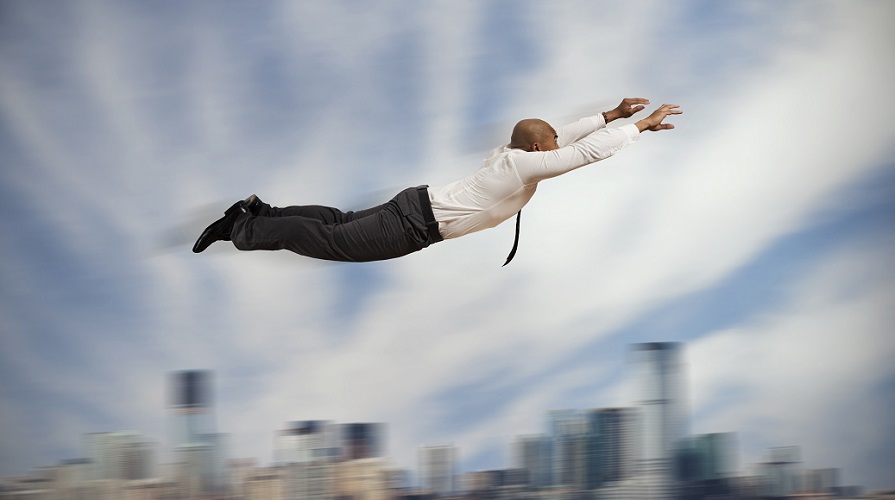
The third exercise for the latissimus dorsi muscle is the pelvic lift. Turn on your back and press your lower back into the floor by pulling in your tummy. Place your arms at your sides and bend the knees with your feet flat on the floor. Using your back muscles, slowly lift the pelvis up, hold this position without experiencing pain, and gently lower the pelvis back the floor. Repeat at least ten times, always at a gentle pace.
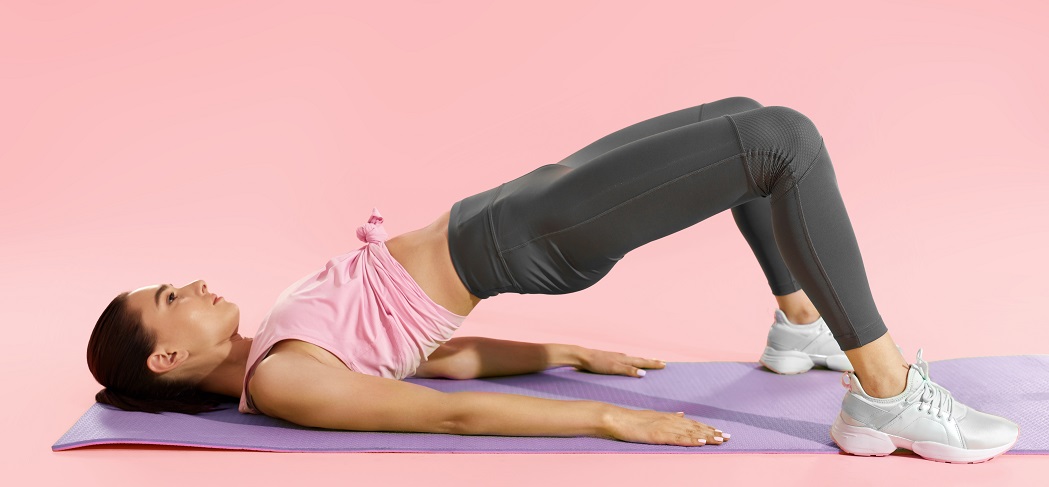
Regular latissimus dorsi stretch exercises reduce the risk of back pain as they not only allow this muscle to stretch but also to relax. Returning to position in a slow and gentle manner is just as important as the stretch.
Quiz
